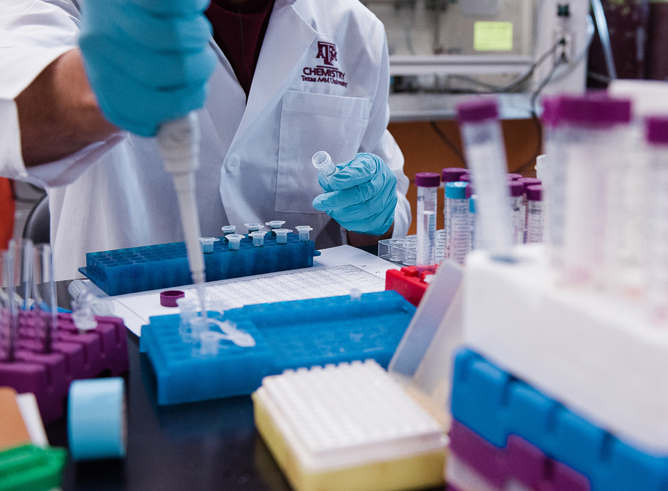Antiviral immune responses: Scientists study signaling pathway

Texas A&M University scientists are providing new insight into the molecular mechanisms behind a key cellular signaling pathway involved in antiviral immune responses they believe can be exploited in the fight against diseases from coronaviruses to cancer.
In research published online earlier this month as an accelerated article in the journal Nature, Texas A&M chemist and 2018 Presidential Impact Fellow Wenshe Ray Liu and Texas A&M biochemist Pingwei Li teamed up to take a closer look at enzyme and protein-related activity within the cGAS-STING signaling pathway — specifically, the enzyme cGAS’ proclivity to bind with nucleosomes within healthy host cells to avoid autoimmune responses. Their goal was as much to understand how the enzyme protects as to explore how it prevents other health-critical processes, from DNA damage repair to cell death.
Like bacteria, Liu notes that viruses have a silent partner in their invasive missions: nucleic acid. Once released inside and detected by a host’s otherwise healthy cells, that nucleic acid triggers a potent protective immune response, providing telltale clues at the scene of every infectious crime.
Once the host’s immune system kicks into action, an enzyme known as cyclic GMP-AMP synthase (cGAS) catalyzes the synthesis of cyclic GMP-AMP (cGAMP), which then acts as a secondary “messenger” molecule by binding to the adaptor protein STING. These messenger molecules direct the activation of other protein complexes that stimulate the induction of cytokines, such as interferons, which not only kick-start the inflammation that gives immune cells quicker access to the infection site but also regulate innate antiviral immunity.
Beyond the key role it plays in antiviral immune response, Liu says the cGAS-STING signaling pathway also has been shown to be involved in cancers, autoimmune and inflammatory diseases such as systemic lupus erythematosus, and Aicardi–Goutières syndrome.
“cGAS senses DNA in a sequence-independent manner, meaning it binds to any DNA, regardless of its sequence,” Liu said. “However, cGAS does not react to host DNA, or DNA found within its own cellular genome under normal conditions. Considering there are billions of base pairs of DNA in the mammalian genome, this fact raises the question about how cGAS distinguishes between viral and host DNA.”
Li says one prevalent explanation is that cGAS is sequestered in another part of the cell known as the cytosol. Because host DNA is found exclusively in a cell’s nucleus and not the cytosol, this explanation hinges on the fact that cGAS cannot access host DNA, which is surrounded by the nuclear membrane. Liu notes this concept has been challenged by several recent studies demonstrating that cGAS also is located in the nucleus, where its activity is suppressed. In addition, it is tightly tethered to chromatin, a tightly packed form of DNA within the nucleus.
More from the College of Science

